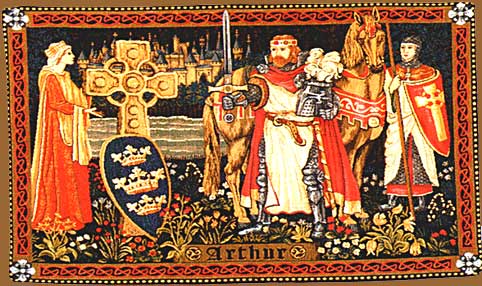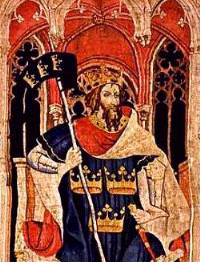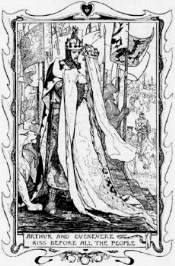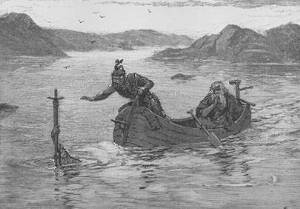|
King Arthur
He didn't rule England. He didn't have a sword named Excalibur. He didn't have a wizard named Merlin. He didn't have a round table. He didn't have a wife named Guenevere who had an affair with a knight named Lancelot. He didn't have a half-sister named Morgana trying to kill him. He didn't have a father named Uther Pendragon. He didn't search for the Holy Grail. He didn't have a castle called Camelot. And he didn't pull a sword out of a stone. Oh, and he might not even have been a king. But his name was Arthur, so that's something. The historical basis for King Arthur is little more than a footnote. There's a long document called the Easter Annals which summarizes the early history of Wales, in which the following entries appear:
That's it. Welcome to King Arthur.
On the basis of the tiny ledger entries above, determined researchers have found other snippets of references which support the idea that there was some guy named more or less Arthur who had some vague sort of following and fought a couple battles. A historical document dated a few hundred years later listed 12 battles that Arthur took part in, including the battle for "Guinnion fort, [in which] Arthur carried the image of the holy Mary, the everlasting Virgin, on his shield, and the heathen were put to flight on that day, and there was great slaughter upon them, through the power of Jesus Christ and the power of the holy Virgin Mary, his mother." Because, you know, the Virgin Mary is synonymous with great slaughter. The first sketchy outlines of what we now know as the tale of King Arthur appear in the work of a 12th century hack named Geoffrey of Monmouth, who wrote a propaganda history of the kings of Britain designed to solidify the claims of the current title holder (a tactic later adopted by other hacks like William Shakespeare, whose so-called "histories" draw extensively on Geoffrey's ramblings).
According to Geoffrey, Merlin conjured Stonehenge out of thin air around the fifth or sixth century. Take that, prehistoric Celts! Geoffrey's version of the King Arthur story would form the template for all the eight gazillion variations that would follow. Basically, this story is that a guy named Uther Pendragon date rapes a woman with the assistance of Merlin, and she becomes pregnant. The resulting child is, of course, Arthur. The boy grows up to be a warrior, who fights off the invading Saxons, then sets up a regime of his own. He becomes king and sets off on a war of conquest, which is foiled only after his nephew, Mordred, stages a coup back at the castle. Arthur returns to deal with the usurper and is killed.
About 100 years later, the medieval romances began. Medieval romances are florid, overdone tales of gallantry, chivalry and derring-do which are distinguished by their ability to be completely unreadable to modern audiences. The medieval romance writers just loved the King Arthur story, and they went to town with it. Epic tales were crafted... and crafted... and crafted.... and crafted... and crafted. French author Chretian de Troyes wrote the most famous and influential of these, Le Mort d' Arthur and well as several related tales, which in toto made up just about every element of the Arthurian legend that Geoffrey had forgotten to make up, including Camelot, the Round Table, Lancelot and his affair with the queen, Parsifal and the Holy Grail. Chretian's template became the basis for all versions of the story to follow, from Alfred Lord Tennyson to Monty Python (arguably the funniest movie ever made). It also solidified this grievously incorrect notion that the whole vast epic was somehow grounded in historical fact. Revisionist history is a popular pastime in any culture, but the British were particularly dogged about the practice. By the end of the 12th century, local legends that the island of Glastonbury had some connection to King Arthur were glorious vindicated in the most clumsy and heavy-handed bit of hoaxery this side of the moon landing.
A really big tent was erected around the sight of the excavation, protecting the delicate work from prying eyes. Lo and behold, a short while later, the bodies of Arthur and Guenevere emerged from the behind the curtains. Entirely coincidentally, this transformed the dying Abbey into a lucrative tourist trap for the gullible — which it remains to this day. Legend has it that Arthur, like Jesus, will come again, shortly before the end of the world. If so, he has a lot of 'splaining to do. Given the romantic adulation the British lavish on their royalty, and the wild distortions built around will they really welcome a bearskin-garbed, illiterate, unwashed barbarian soldier as the pinnacle of all things British? Then again, after living with Prince Charles lo these many years, maybe a manly (if rough-hewn) icon is just what the doctor ordered...
|

 Of course, the story doesn't stop there, or else this would be a pretty pointless topic for an article. King Arthur became one of those weird historical figures around whom a vast legend grew, kind of like
Of course, the story doesn't stop there, or else this would be a pretty pointless topic for an article. King Arthur became one of those weird historical figures around whom a vast legend grew, kind of like  "The History of the Kings of Britain" mixes some established historical fact with a lot of wholly fabricated nonsense. It's not known exactly what portion of the Arthurian story is fabricated, but rigorous scientific studies have determined that it's "a lot." Geoffrey is credited with concocting Merlin, among other characters, out of scattered and inconsistent urban legends. Merlin, of course, is the wizard and prophet who pulls the strings behind the King Arthur administration, kind of like the
"The History of the Kings of Britain" mixes some established historical fact with a lot of wholly fabricated nonsense. It's not known exactly what portion of the Arthurian story is fabricated, but rigorous scientific studies have determined that it's "a lot." Geoffrey is credited with concocting Merlin, among other characters, out of scattered and inconsistent urban legends. Merlin, of course, is the wizard and prophet who pulls the strings behind the King Arthur administration, kind of like the  Geoffrey was the source of many major elements of the Arthur story, including the magic sword (as yet unnamed), Arthur's evil half-sister Morgan Le Fay, the magic island of Avalon, Queen Guenevere, and the king's company of knights.
Geoffrey was the source of many major elements of the Arthur story, including the magic sword (as yet unnamed), Arthur's evil half-sister Morgan Le Fay, the magic island of Avalon, Queen Guenevere, and the king's company of knights.  After a terrible fire, the once-wealthy Abbey at Glastonbury had fallen on hard times. In the middle of this difficult period of reconstruction, the monks were hard pressed to come up with a revenue stream that would support reconstruction. Someone came up with the bright idea to excavate the area and find Arthur's tomb, which was reputed to be around there somewhere.
After a terrible fire, the once-wealthy Abbey at Glastonbury had fallen on hard times. In the middle of this difficult period of reconstruction, the monks were hard pressed to come up with a revenue stream that would support reconstruction. Someone came up with the bright idea to excavate the area and find Arthur's tomb, which was reputed to be around there somewhere.